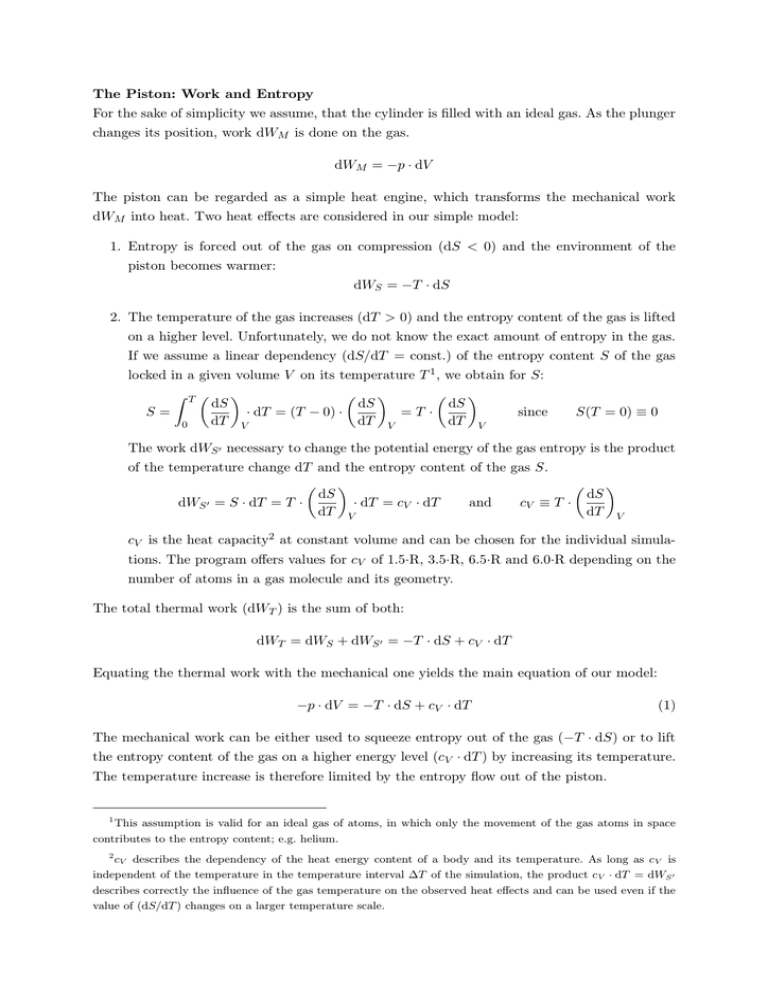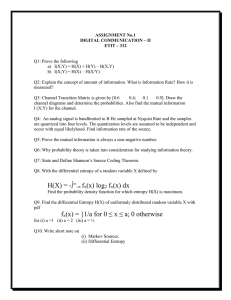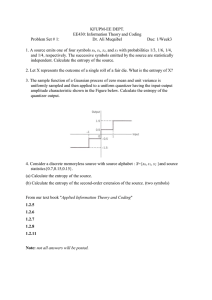The Piston: Work and Entropy For the sake of simplicity we assume
advertisement

The Piston: Work and Entropy For the sake of simplicity we assume, that the cylinder is filled with an ideal gas. As the plunger changes its position, work dWM is done on the gas. dWM = −p · dV The piston can be regarded as a simple heat engine, which transforms the mechanical work dWM into heat. Two heat effects are considered in our simple model: 1. Entropy is forced out of the gas on compression (dS < 0) and the environment of the piston becomes warmer: dWS = −T · dS 2. The temperature of the gas increases (dT > 0) and the entropy content of the gas is lifted on a higher level. Unfortunately, we do not know the exact amount of entropy in the gas. If we assume a linear dependency (dS/dT = const.) of the entropy content S of the gas locked in a given volume V on its temperature T 1 , we obtain for S: Z T dS dS dS S= · dT = (T − 0) · =T· since dT V dT V dT V 0 S(T = 0) ≡ 0 The work dWS 0 necessary to change the potential energy of the gas entropy is the product of the temperature change dT and the entropy content of the gas S. dS dS dWS 0 = S · dT = T · · dT = cV · dT and cV ≡ T · dT V dT V cV is the heat capacity2 at constant volume and can be chosen for the individual simulations. The program offers values for cV of 1.5·R, 3.5·R, 6.5·R and 6.0·R depending on the number of atoms in a gas molecule and its geometry. The total thermal work (dWT ) is the sum of both: dWT = dWS + dWS 0 = −T · dS + cV · dT Equating the thermal work with the mechanical one yields the main equation of our model: −p · dV = −T · dS + cV · dT (1) The mechanical work can be either used to squeeze entropy out of the gas (−T · dS) or to lift the entropy content of the gas on a higher energy level (cV · dT ) by increasing its temperature. The temperature increase is therefore limited by the entropy flow out of the piston. 1 This assumption is valid for an ideal gas of atoms, in which only the movement of the gas atoms in space contributes to the entropy content; e.g. helium. 2 cV describes the dependency of the heat energy content of a body and its temperature. As long as c V is independent of the temperature in the temperature interval ∆T of the simulation, the product c V · dT = dWS 0 describes correctly the influence of the gas temperature on the observed heat effects and can be used even if the value of (dS/dT ) changes on a larger temperature scale.







